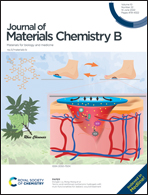A deep tumor penetration nanoplatform for glycolysis inhibition and antimetastasis of breast cancer†
Abstract
The poor penetration into deep tumor tissues of nanomedicines could not inhibit the production of lactic acid by deep tumor glycolysis, which leads to the accumulation of lactic acid and promotes tumor metastasis. In order to increase tumor penetration, it remains challenging to avoid tumor metastasis by the direct degradation of the extracellular matrix (ECM). Herein, in order to increase tumor penetration, a nano-platform, which can reduce extracellular matrix (ECM) production, and inhibit the glycolysis of deep tumors by releasing ethylenediaminetetraacetic acid (EDTA) is reported. In this design, EDTA and indocyanine green (ICG) are encapsulated in the liposome by a thin-film hydration method, and folic acid (FA) and the polyethyleneimine polymer (FA-PEI) are applied to coat the surface of liposomes through electrostatic interactions, and the FA-EDTA/ICG-Lip nanoparticles are obtained. FA-EDTA/ICG-Lip NPs can release EDTA and ICG in lysosomes (pH 4.5) to reduce ECM production by down-regulating transforming growth factor β (TGF-β) and activating an immune response by inducing tumor cell immunogenic cell death (ICD), respectively. Simultaneously, EDTA inhibits glycolysis of deep tumors by chelating Mg2+. By avoiding tumor metastasis, the strategy of indirectly reducing ECM production is demonstrated to enhance tumor penetration and inhibit deep tumor glycolysis.



 Please wait while we load your content...
Please wait while we load your content...